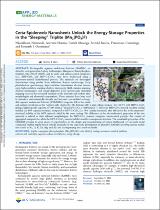| dc.description.abstract | Rechargeable aqueous mobile-ion batteries (RAMIBs) are attractive next-generation battery technologies. Manganese fluorophosphate (triplite), Mn2(PO4)F (MFP), and its ceria- and carbon-coated composites (i.e., MFP-CeO2 and MFP-C-CeO2), have been synthesized using a microwave-assisted hydrothermal process. The materials are thoroughly characterized using powder X-ray diffraction, Raman spectroscopy, X-ray photoelectron spectroscopy, high-resolution transmission electron microscopy, high-resolution scanning electron microscopy (field-emission scanning electron microscopy), and energy-dispersive X-ray spectroscopy elemental mapping to prove the successful synthesis of the materials and confirm their morphologies and elemental compositions. These materials have been used to introduce environmentally friendly and low-cost ceria-enabled rechargeable aqueous sodium-ion batteries (CERASIBs) using zinc foil as the anode and sodium perchlorate as the "water-in-salt"electrolyte. The batteries offer a high voltage window (1.6-2.2 V), with MFP-C-CeO2 giving a higher specific capacity of ∼195 mAh g-1 than MFP-CeO2 (∼100 mAh g-1). However, MFP-CeO2 showed excellent cycling stability (ca. 99% capacity retention) compared to MFP-C-CeO2 (ca. 78% capacity retention) after 300 cycles due to the impressive structural stability of the MFP material, aided by the ceria coating. The difference in the electrochemical properties of the two materials is related to their different morphologies: the MPF-CeO2 material comprises micron-sized particles that consist of aggregated nanoparticles, while the MPF-C-CeO2 material exhibits mostly a nanoporous structure. The remarkable properties of the CERASIB promise to open doors of opportunities for the design and manufacturing of various lanthanoid- or rare-earth metal compound-enabled triplite-based cathode materials for the large-scale development of affordable RAMIBs involving various mobile ions (such as Na, Li, K, Zn, Mg, and Al) and accompanying zinc anode materials. | en_US |

